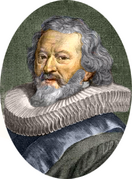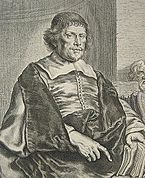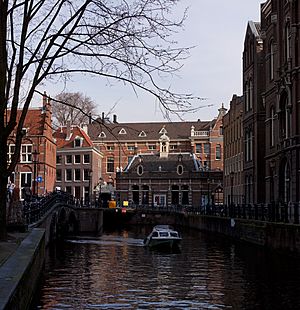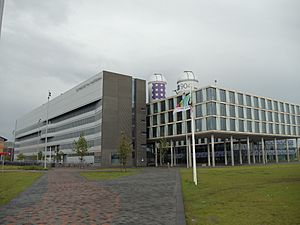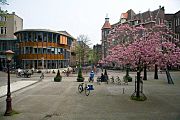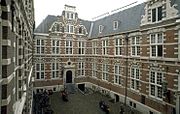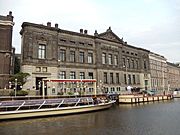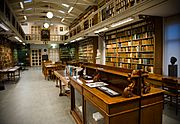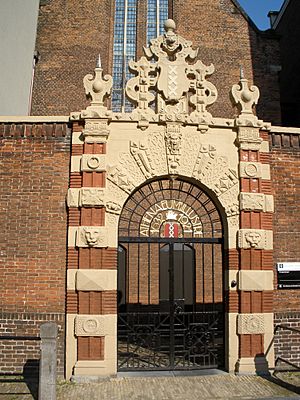University of Amsterdam facts for kids
|
Universiteit van Amsterdam
|
|
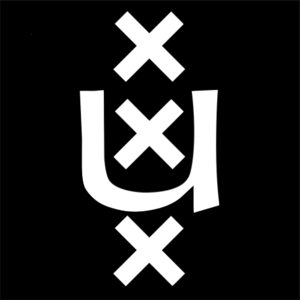 |
|
| Latin: Universitas Amstelodamensis | |
|
Former names
|
Athenaeum Illustre (1632–1877) Municipal University of Amsterdam (1877–1961) |
|---|---|
| Type | Public |
| Established | 1632, elevated to university status in 1877 |
| President | Edith Hooge |
| Rector Magnificus | Peter-Paul Verbeek |
|
Academic staff
|
2,425 |
|
Administrative staff
|
2,369 |
|
Total staff
|
5,777 (2022) |
| Students | 42,171 (2022) |
| Location |
,
,
52°22′6″N 4°53′25″E / 52.36833°N 4.89028°E |
| Campus | Urban |
| Colours | Red, Black, White and Grey |
| Affiliations | LERU, UNICA, EUA, Universitas 21 |
The University of Amsterdam (UvA) is a big public research university. It is located in Amsterdam, Netherlands. It started in 1632, making it one of the oldest schools in the Netherlands.
The UvA is one of the largest universities in Europe. It has over 42,000 students and many staff members. Its main campus is in the center of Amsterdam. The university has seven main study areas, called faculties. These include Humanities, Social and Behavioural Sciences, Economics and Business, Science, Law, Medicine, and Dentistry.
The University of Amsterdam works closely with other universities around the world. It is part of groups like the League of European Research Universities (LERU). Many famous people have studied or worked here. Six Nobel Laureates and five prime ministers of the Netherlands are among them.
Contents
A Look Back: University History
How the University Started (1632–1877)
In January 1632, the Athenaeum Illustre of Amsterdam was founded. It was a school set up by the city of Amsterdam. Its main focus was teaching medicine. The first two professors were Gerardus Vossius and Caspar Barlaeus.
The Athenaeum Illustre offered education like other higher schools. However, it could not give out doctoral degrees. Students had to finish their studies at another university if they wanted a doctorate. Amsterdam was a city with a lot of religious freedom. This allowed other schools to open, like those for surgeons or religious studies. Students from these schools often took classes at the Athenaeum Illustre.
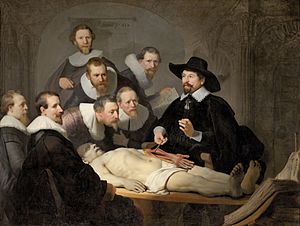
In 1815, the school was given a new goal. It was to "spread good taste, culture, and learning." It also aimed to help young men who could not spend a lot of time at a university. The Athenaeum started offering classes for professional training in the 1800s. This included training for pharmacists and surgeons. The school worked with other medical and religious institutions in Amsterdam.
The Athenaeum stayed small for a long time. It had no more than 250 students and eight professors.
Becoming a City University (1877–1961)
In 1877, the Athenaeum Illustre became the Municipal University of Amsterdam. It was given the right to give out doctoral degrees. This meant it had the same rights as national universities. But it was still paid for by the city of Amsterdam. The city council chose the professors and teachers. This led to a very diverse group of staff.
During this time, the university grew a lot. Especially its science department became very strong. Many Nobel prize winners were part of its staff. These included Tobias Asser, Christiaan Eijkman, Jacobus Henricus van 't Hoff, Johannes Diderik van der Waals, Pieter Zeeman, and Frits Zernike.
The university's city status also meant it added new study areas early on. These included Economics and Social Sciences. After World War II, the cost of university education went up a lot. This made it harder for the university to grow.
A National University Today (1961–Present)
In 1961, the Dutch government made the university a national one. It was then named the University of Amsterdam. The government now provided the money instead of the city. The power to choose professors moved to a board of governors. The city of Amsterdam had some influence until 1971.
In May 1969, students protested at the university's main building, the Maagdenhuis. They wanted more say in how the university was run. The protest lasted for days and police had to end it. In the 1970s and 1980s, there were often student protests at the university.
The university has grown a lot since 1961. It went from 7,500 students in 1960 to over 32,000 in 2010. In 2007, the UvA started building the Science Park Amsterdam. This is a large campus for the Faculty of Science and a new sports center. Most of the park is now finished. The University of Amsterdam also works closely with the Hogeschool van Amsterdam. In 2008, the UvA and VU University started the Amsterdam University College together. This college offers a special three-year Bachelor's program.
Student Protests in 2015
In February 2015, students occupied two university buildings. They were protesting against planned budget cuts. These cuts were due to the university's financial problems. The first occupation ended with 46 protesters being arrested. The next day, students occupied the Maagdenhuis again. This protest lasted 45 days before police ended it.
The University Logo
The University of Amsterdam's logo is a black square with three white X-shapes. It also has a white "U." This design comes from the coat of arms of Amsterdam. The three X-shapes are called Saint Andrew's Crosses. Some people say they stand for the three big problems Amsterdam faced: fire, floods, and the Black Death. Another idea is that they represent three crossings in the River Amstel. However, historians say these ideas are not true. They believe the coat of arms comes from a lord of Amsterdam named Jan Persijn. The "U" in the logo stands for "university." The colors and crosses represent the city of Amsterdam.
University Locations
The University of Amsterdam is spread out across the city. Its buildings are old and new, mixed in with the city itself. This means students and city residents often meet. It helps Amsterdam stay connected to the university. Most of the UvA's buildings are in the heart of Amsterdam. Only the Science, Medicine, and Dentistry faculties are outside the city center.
City Centre Buildings
The main offices and most faculties are in Amsterdam's historic City Centre. This area is inside the famous canal ring, which is a UNESCO World Heritage Site. Buildings here range from the 15th century to today. Many different building styles can be seen.
Some important buildings include the Agnietenkapel, Maagdenhuis, Oost-Indisch Huis, Bushuis, and Oudemanhuispoort. These are all national monuments. The 15th-century Agnietenkapel was a monastery chapel. It became the first home of the Athenaeum Illustre in 1631. The Agnes Gate in front of it is a key symbol of the university.
The Binnengasthuis is a former hospital now used by the university. It is seen as the heart of the UvA. The Maagdenhuis is the main office for the UvA and HvA. It was built in the late 1700s as an orphanage. The Oost-Indisch Huis was built in 1606. It used to be the main office for the Dutch East India Company. Now, the UvA uses it. The Oudemanhuispoort became a university building in 1880. It was built in 1602 as a retirement home. Today, it houses some Humanities departments. The Bushuis was built in 1606 as an armory. It is now part of the University Library.
Science Park Campus
The Faculty of Science is located on the east side of the city. It is at the new Science Park Amsterdam. This large campus has UvA's science buildings, research centers, student housing, and a sports center. The campus was built to attract top students and researchers. The University of Amsterdam, the City of Amsterdam, and the Netherlands Organization for Scientific Research worked together on it. In 2012, the Amsterdam University College also moved to the Science Park UvA campus.
Academic Medical Centre
In the southeastern part of the city, the Faculty of Medicine is located. It is in the Academic Medical Center (AMC). This is the Faculty of Medicine's teaching hospital. It was created in 1983 when the UvA Faculty of Medicine joined with two hospitals. The Emma Children's Hospital also moved there in 1988. It is a major trauma center in Amsterdam. It works closely with the VU University Medical Center (VUmc).
Academic Centre for Dentistry Amsterdam
The Faculty of Dentistry is in the Academic Centre for Dentistry Amsterdam (ACTA). This is in the southern Zuidas area, near the VU University Medical Center. It was formed in 1984. This happened when the University of Amsterdam and the Vrije Universiteit combined their Dentistry schools.
Roeterseiland Campus
The Roeterseiland Campus is an open city campus. It is designed for modern teaching and research. The Faculties of Economics and Business and Social and Behavioural Sciences are here. The Faculty of Law also moved to this campus in August 2017.
How the University is Organized
University Faculties
The university is divided into seven main study areas, called faculties. Each faculty has a leader called a dean. Students must be accepted into the faculty of their chosen program.
Faculty of Science
The Faculty of Science (FNWI) covers many areas of research and teaching. Its research includes astronomy, physics, math, computer science, life sciences, chemistry, and biology. The faculty offers 28 degree programs. Seven of these are joint programs with the Vrije Universiteit. Students from 51 different countries study here. The Faculty of Science has about 6,800 students and 1,700 staff. Many staff members are from other countries. The main buildings are at the Science Park Amsterdam campus.
Faculty of Humanities
The Faculty of Humanities (FGw) has six departments. These include Dutch studies, History, European Studies and Religion. Also, Archaeology and Classics, Language and Literature, Media studies, Philosophy, and Art and Cultural studies. It is the largest humanities faculty in the Netherlands. It has over 6,000 students and about 1,000 employees. In 2011, it was ranked number one in the Netherlands for Philosophy and Linguistics.
Faculty of Social and Behavioural Sciences
The Faculty of Social and Behavioural Sciences (FMG) is the largest school for social and behavioral sciences in the Netherlands. It has about 10,000 students and 1,200 staff. The faculty has six departments. These include Political Science, Sociology and Anthropology, Communication Science, and Psychology. Also, Social Geography, Planning and International Development Studies, and Educational sciences. In 2011, it was ranked the best in the Netherlands for Sociology and Geography.
Faculty of Economics and Business
The Faculty of Economics and Business (FEB) started in 1922. It includes the Amsterdam School of Economics (ASE) and the Amsterdam Business School (ABS). It has about 4,000 students and nearly 600 staff. It is highly ranked in Economics & Econometrics and Accountancy & Finance.
Faculty of Law
The Faculty of Law (FdR) is at the Roeterseiland campus. It used to be in the historic Oudemanhuispoort building. It has about 3,700 students and 330 academic staff. More than half of the academic staff are women. The faculty offers many Master of Laws (LLM) programs. Research here is done by five research institutes. They focus on areas like International law, Private law, and Environmental law.
In 2015, a large donation helped create the Julia Henriëtte Jaarsma-Adolfs scholarship fund. This fund helps students studying law. It was the biggest private donation ever given to a Dutch university.
Faculty of Medicine
The Faculty of Medicine (FdG) welcomes about 350 new students each year. The first three years focus on themed teaching. The next three years involve training internships in and outside the Amsterdam UMC.
Faculty of Dentistry
The Academic Center for Dentistry in Amsterdam (ACTA) started in 1984. It was formed when the dentistry schools of the Universiteit of Amsterdam and the Vrije Universiteit Amsterdam joined. ACTA does scientific research, teaches, and provides dental care. It is one of the largest dentistry programs in the world. It has 500 staff members and about 1,000 students.
How the University is Managed
The University of Amsterdam is led by an executive board. The seven faculties are then managed by their deans. Teaching and research happen in different departments and institutes within each faculty. The UvA has a yearly budget of about €600 million.
In 1992, the university created UvA Holding BV. This was to manage its business activities. The university owns all the companies under this holding.
Working with Other Countries
The UvA is very open to international students and researchers. Amsterdam attracts students from all over the world. Over 2,500 international students and researchers from more than 100 countries come here.
The UvA has many partner universities in other countries. This helps students and staff to study or work abroad. Within Europe, the UvA has exchange agreements with over 200 schools. Outside Europe, it works closely with about 40 universities.
Student Life and Learning
The university is approved by the Dutch Ministry of Education, Culture and Science. This means it meets national standards for quality. It has "WO" status, which means it is a research university. Dutch students need to complete a six-year program to get into these universities. Only about 15% of students pass this program.
In 2015–2016, full-time students from the EU paid about €1,951 per year. Students from outside the EU paid between €9,000 and €25,000 per year. The cost for non-EU students depends on their study area. The university offers many scholarships. These include the UvA Amsterdam Excellence Scholarship (AES) and Amsterdam Merit Scholarships.
The faculties offer 59 Bachelor's programs and 133 Master's programs. They also have 10 postgraduate programs. The school year runs from early September to mid-July. It has two semesters. There are no mid-term breaks, only short holidays around Christmas and New Year.
Demographics of the student body Dutch (65%) Other EEA citizen (22%) Non-European (13%)
Who Studies Here?
In 2010, the university had 32,739 students. This included undergraduate, master's, and doctoral students. About 66% of students were Dutch citizens. The other 34% were international students. Over 2,500 international students and researchers come from more than 100 countries. Most students (91%) study full-time.
Students are enrolled in seven faculties and the Amsterdam University College. The largest groups were in Humanities (24%) and Social & Behavioral Sciences (30%). About 20% of Bachelor's students finish their degree in three years. About 71% of Master's students finish in two years. In 2007, most graduates found jobs within 1.5 years.
University Rankings
| University rankings | |
|---|---|
| Global – Overall | |
| ARWU World | 101-150 (2024) |
| CWUR World | 82 (2024) |
| CWTS World | 54 (2024) |
| QS World | 55 (2025) |
| THE World | =58 (2025) |
| USNWR Global | =33 (2024-25) |
The UvA is ranked among the top universities in the world. According to US News, it is among the top 10 best universities in Europe. It is also ranked 53rd in the 2023-2024 QS World University Rankings. The UvA is one of only two Dutch universities in the top 100 worldwide.
In the 2023 ARWU Global Ranking of Academic Subjects, the UvA was ranked first globally in Communication. Other UvA subjects with high rankings include Psychology (8th), Sociology (10th), and Political Science (15th).
The 2011-12 Times Higher Education World University Rankings placed the University of Amsterdam 30th in Arts & Humanities. It was 40th in Social Sciences. This made it the highest-ranked Dutch university in these fields.
Research and Resources
The University of Amsterdam is one of Europe's largest research universities. In 2010, it produced over 7,900 scientific papers. The university spends about €100 million on research each year. It also gets money from other sources, including companies. Professors often win research awards and grants. Research is organized into fifteen main areas. Twenty-eight research institutes within the faculties manage this research.
The University of Amsterdam has a very large central University Library (UB). It holds over four million books. Many departments also have their own libraries. The main library is in the city center. It has millions of books, manuscripts, and maps. It also has special collections on Jewish history and social movements. Students can study quietly in three reading rooms. The university's publishing company, the Amsterdam University Press, has published over 1,400 titles.
Besides its libraries, the UvA has five museums.
- The Allard Pierson Museum has ancient items from Ancient Egypt, Ancient Greece, and Italy.
- The University Museum shows the history of the UvA from 1632 until today.
- The Museum Vrolik has anatomical and zoological specimens.
- The J.A. Dortmond Museum of Script shows the history of writing.
- The UvA Computer Museum shows how old computers worked.
- The Zoological Museum Amsterdam at the Amsterdam Artis Zoo has millions of animal specimens for research.
Student Life and Activities
At UvA, students can join many groups and activities. These include the ASVA Student Union and the CREA Cultural Center. There is also a new University Sports Center and a student restaurant. The university offers religious services, career help, and support for international students. Students are represented in student councils.
The University Sports Center (USC) offers over 50 sports. Students and staff get discounts. Sports include ice skating, tennis, rowing, and dancing.
The CREA Cultural Center offers courses and projects in drama, music, dance, and visual arts. It also has a bar and a theater.
Most students travel by bicycle. Amsterdam also has good public transport. This includes the Metro, trams, buses, and ferries.
Where Students Live
The university tries to help most international first-year students find housing. This is done through non-profit housing groups. These groups offer apartments in different parts of Amsterdam and a nearby suburb. Students can find single rooms or shared rooms. Rooms can be a short bike ride or up to 45 minutes away from the city center.
The university advises students to find housing before coming to Amsterdam. Housing options can be limited.
Famous People from the University
Professors and alumni (former students) of the University of Amsterdam have included six Nobel Prize winners. They also include seven Spinoza Prize winners.
Notable Professors
Famous current and former professors include:
- Tobias Asser, who won the Nobel Peace Prize in 1911.
- Mathematician Luitzen Egbertus Jan Brouwer.
- Jacobus Henricus van 't Hoff, Nobel Prize winner in Chemistry (1901).
- Johannes Diderik van der Waals, Nobel Prize winner in Physics (1910).
- Pieter Zeeman, Nobel Prize winner in Physics (1902).
- Frits Zernike, Nobel Prize winner in Physics (1953).
- Scholar of religion, C. Jouco Bleeker.
Famous Alumni in Arts
In the arts, notable alumni include:
- Cultural analyst Ien Ang.
- Sophia Antoniadis, the first female professor at Leiden University.
- Writers Menno ter Braak, Willem Frederik Hermans, J. Slauerhoff, and Simon Vestdijk.
- Emmy award-winning producer Michael W. King.
- Actor Jeff Wilbusch.
- Art historian Charlotte Rulkens.
- Roman law expert Boudewijn Sirks.
Famous Alumni in Media
- Thomas von der Dunk, a Dutch cultural historian, writer, and columnist.
Famous Alumni in Politics and Government
Alumni in politics and government include:
- Former Prime Ministers Pieter Cort van der Linden and Joop den Uyl.
- Former Belgian prime minister Charles Michel.
- Former president of the European Central Bank Wim Duisenberg.
- Member of the European Parliament Thijs Berman.
- Former Secretary General of NATO Joseph Luns.
- Princess Viktória de Bourbon de Parme from the Dutch royal family.
- Many former ministers in the Dutch government.
- Prime Minister of Sint Maarten Leona Marlin-Romeo.
Famous Alumni in Science
Alumni in science include:
- Christiaan Eijkman, Nobel Prize winner for Medicine (1929).
- Alec Jeffreys, who invented DNA fingerprinting.
- Physician M.A. Mendes de Leon, a founder of gynecology in the Netherlands.
- Astrophysicist Anton Pannekoek.
- String theorist Erik Verlinde.
- Dutch psychiatrist and World War II hero Tina Strobos.
- ESA astronaut André Kuipers.
- Dutch botanist Hendrik de Wit.
- Nutrition education pioneer Sarah Bavly.
- Research scientist Ilkay Altintas.
- Malariologist Arjen Dondorp.
- Anaesthetist Menno Sluijter.
- Social geographer Alida Edelman-Vlam.
- Anna Petronella van Heerden, the first Afrikaner woman doctor in South Africa.
Famous Alumni in Sports
- Max Euwe, who was the World Chess Champion from 1935–1937.
Images for kids
-
An ancient Egyptian sarcophagus in the Allard Pierson Museum dating from around 1000 BCE
See also
 In Spanish: Universidad de Ámsterdam para niños
In Spanish: Universidad de Ámsterdam para niños


